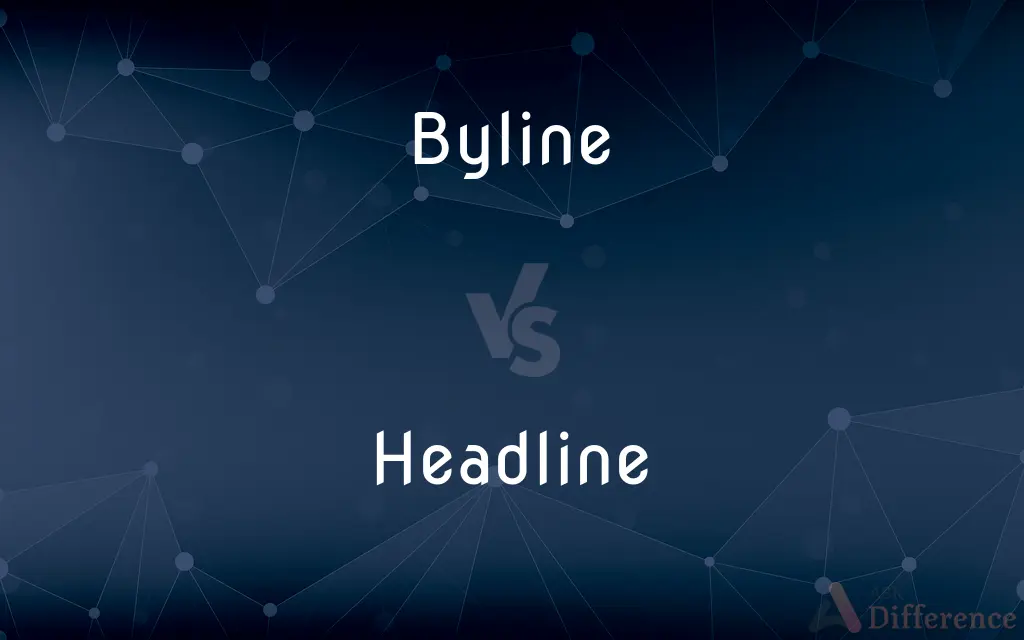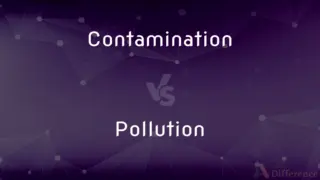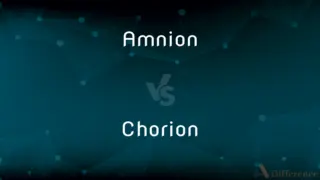Byline vs. Headline — What's the Difference?
By Urooj Arif & Fiza Rafique — Updated on March 10, 2024
A byline credits the author, while a headline summarizes the content.

Difference Between Byline and Headline
Table of Contents
ADVERTISEMENT
Key Differences
A byline is found in articles and news stories, attributing the work to its author, often including the writer's name and sometimes their position or other relevant details. It serves to acknowledge the author's contribution and can lend credibility to the piece based on the author's reputation. The headline, on the other hand, is a brief and engaging summary of the article's content, designed to grab the reader's attention and provide insight into the story's focus. It plays a crucial role in enticing readers to delve into the article.
While the byline is primarily about giving credit where it's due, the headline is about communication and marketing, aiming to succinctly convey the essence of the article and compel the audience to read further. The byline remains consistent in its purpose across various articles, showcasing the author's name, whereas headlines vary greatly, reflecting the unique angle and key points of each story.
The placement also differentiates these elements; the byline usually appears at the beginning or end of an article, subtly presenting the author's identity. The headline, however, prominently stands at the top of the article, often in a larger and more distinctive font, making it one of the first elements noticed by readers.
In the realm of digital and print media, both bylines and headlines play significant roles but serve different functions: the byline respects and identifies the authorship, while the headline acts as a gateway, inviting readers into the narrative presented by the piece.
Despite their differences, bylines and headlines are complementary; the byline supports transparency and accountability in journalism, while the headline ensures that the story reaches and resonates with its intended audience, thus enhancing the overall impact and effectiveness of the article.
ADVERTISEMENT
Comparison Chart
Purpose
Credits the author of the article
Summarizes the article's content and attracts readers
Content
Includes the author's name and sometimes their position or credentials
A brief, engaging statement reflecting the article's key points
Role
Acknowledges authorship and lends credibility
Markets the article and entices the reader to engage with the content
Placement
At the beginning or end of the article
At the top of the article, often in larger or bold font
Variation
Consistent in presenting the author's name
Varies greatly, tailored to each article's unique content
Compare with Definitions
Byline
A byline credits the writer of an article.
The byline read By Jane Doe, Staff Writer.
Headline
A headline provides a succinct summary of the article's main points.
Historic Space Launch Draws Global Attention.
Byline
It lends credibility and maintains transparency in journalism.
Recognizing the author encourages accountability and trust in the content.
Headline
Designed to capture the reader's interest and encourage reading the article.
Headlines use dynamic language to intrigue and attract readers.
Byline
Bylines typically follow a consistent format, focusing on the author's identity.
Bylines are often formatted as By [Author's Name].
Headline
Headlines vary greatly, reflecting the content's uniqueness and creativity.
Editors craft headlines to stand out and resonate with the intended audience.
Byline
Can appear at the article's beginning or end, depending on the publication's style.
Some newspapers place bylines at the end of articles to emphasize the content.
Headline
Positioned at the top of the article, often in a distinctive font or style.
The headline's bold font and larger size make it a focal point.
Byline
May include additional details like the author's role or the date.
By John Smith, Senior Political Correspondent, March 10.
Headline
Acts as a critical element in marketing the article to potential readers.
A compelling headline can significantly increase an article's readership.
Byline
The byline (or by-line in British English) on a newspaper or magazine article gives the name of the writer of the article. Bylines are commonly placed between the headline and the text of the article, although some magazines (notably Reader's Digest) place bylines at the bottom of the page to leave more room for graphical elements around the headline.
Headline
The headline or heading is the text indicating the nature of the article below it. The large type front page headline did not come into use until the late 19th century when increased competition between newspapers led to the use of attention-getting headlines.
Byline
A line in a newspaper naming the writer of an article
His byline appeared in the first issue
Headline
The title or heading of an article, especially in a newspaper, usually set in large type.
Byline
(chiefly in soccer) the part of the goal line to either side of the goal.
Headline
Often headlines An important or sensational piece of news.
Byline
A line at the head of a newspaper or magazine article carrying the writer's name.
Headline
A line at the head of a page or passage giving information such as the title, author, and page number.
Byline
To publish (a newspaper or magazine article) under a byline.
Headline
To supply (a page or passage) with a headline.
Byline
(journalism) A line at the head of a newspaper or magazine article carrying the writer's name.
Headline
To present or promote as a headliner
The Palace Theater headlines a magician.
Byline
(sports) A touchline.
Headline
To serve as the headliner of
He headlines the bill.
Byline
To provide (an article) with a byline.
Headline
(journalism) The heading or title of a magazine or newspaper article.
The headline on today's newspaper reads "John Doe Wins Wood-Splitting Competition."
Headline
The line at the top of a page containing the folio or number of the page.
Headline
(entertainment) The top-billed attraction.
Headline
(nautical) A headrope.
Headline
To give a headline to a page or section of a text.
Headline
To present as the main attraction; to have top billing, to be the main attraction.
Headline
The line at the head or top of a page.
Headline
See Headrope.
Headline
A title for an article in a newspaper, sometimes one line, sometimes more, set in larger and bolder type than the body of the article and indicating the subject matter or content of the article.
Headline
A similar title at the top of the newspaper indicating the most important story of the day; also, a title for an illustration or picture.
Headline
To mention in a headline.
Headline
To furnish with a headline (senses 1, 3, or 4).
Headline
To publicise prominently in an advertisement.
Headline
The heading or caption of a newspaper article
Headline
Publicize widely or highly, as if with a headline
Headline
Provide (a newspaper page or a story) with a headline
Common Curiosities
What information can a byline include apart from the author's name?
Apart from the author's name, a byline can include the writer's title, the date of publication, and sometimes the author's location or the context of their expertise.
Why is the headline important?
The headline is crucial because it summarizes the article's content and entices readers to engage with the story, serving as a primary factor in attracting audience interest.
How do headlines influence reader engagement?
Headlines influence reader engagement by providing a compelling or intriguing summary of the article, which can determine whether or not a reader decides to continue reading.
Is the byline always written by the article's author?
The byline typically names the article's author(s), but in some cases, it might include contributors, photographers, or other participants in creating the piece.
What is a byline in journalism?
A byline in journalism is a line in an article that names the author, often including additional details such as their position or contribution date.
How do digital media headlines differ from print?
Digital media headlines often incorporate SEO keywords and are designed to be shareable and clickable, whereas print headlines may focus more on creativity and puns due to the lack of search engine constraints.
Can an article have multiple bylines?
Yes, an article can have multiple bylines if it has several contributors or co-authors, indicating collaborative work.
What role does the byline play in online articles?
In online articles, the byline can enhance credibility and allow readers to explore more work by the author, often linked to the author's profile or other articles.
How are headlines crafted to attract readers?
Headlines are crafted using engaging, dynamic language, sometimes incorporating puns, questions, or provocative statements to spark curiosity and attract readers.
Can a headline be misleading?
Yes, headlines can sometimes be misleading, either unintentionally due to trying to encapsulate complex stories in a few words, or intentionally, in cases of "clickbait," where the headline exaggerates or distorts to attract clicks.
Share Your Discovery

Previous Comparison
Contamination vs. Pollution
Next Comparison
Amnion vs. ChorionAuthor Spotlight
Written by
Urooj ArifUrooj is a skilled content writer at Ask Difference, known for her exceptional ability to simplify complex topics into engaging and informative content. With a passion for research and a flair for clear, concise writing, she consistently delivers articles that resonate with our diverse audience.
Co-written by
Fiza RafiqueFiza Rafique is a skilled content writer at AskDifference.com, where she meticulously refines and enhances written pieces. Drawing from her vast editorial expertise, Fiza ensures clarity, accuracy, and precision in every article. Passionate about language, she continually seeks to elevate the quality of content for readers worldwide.














































